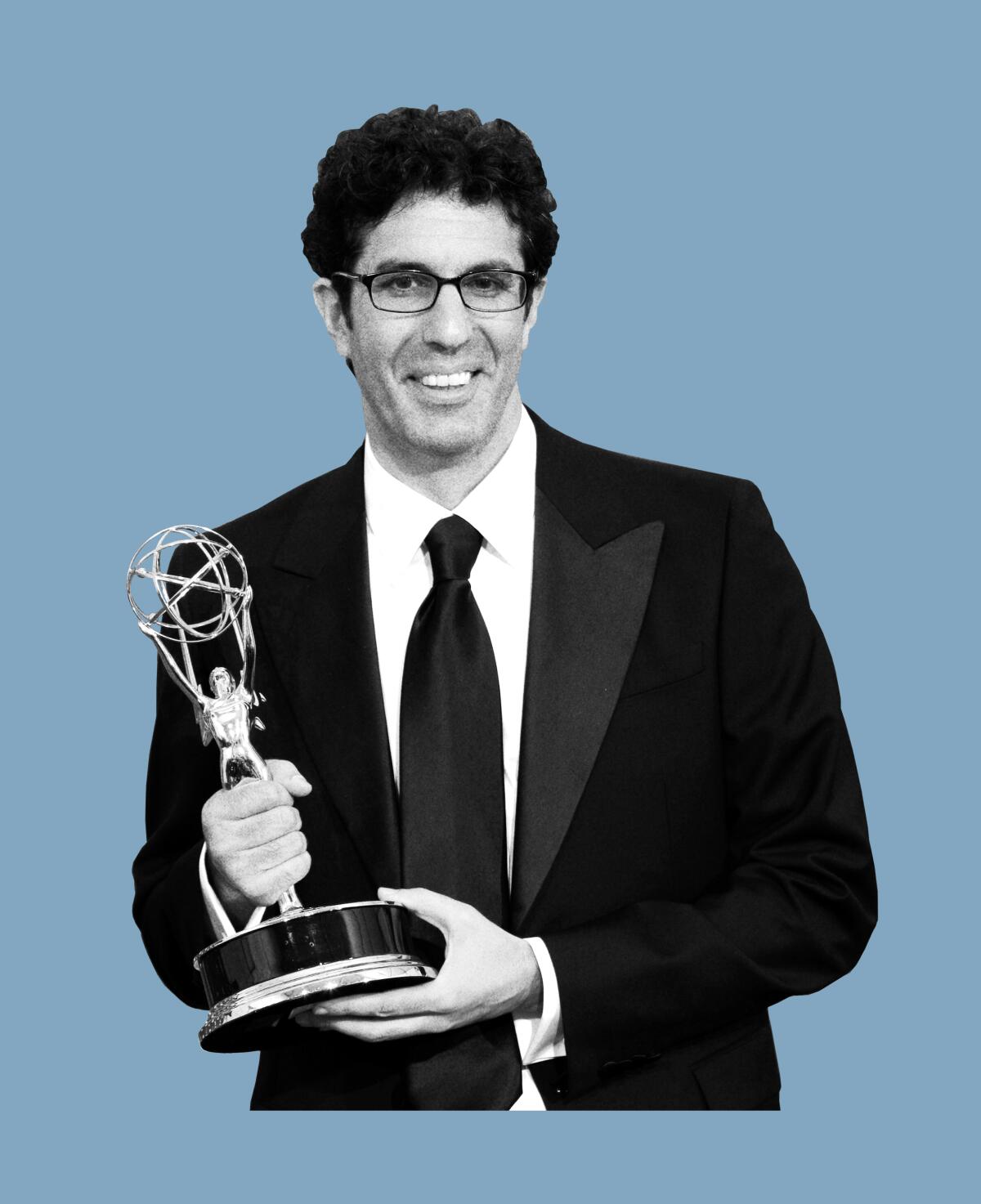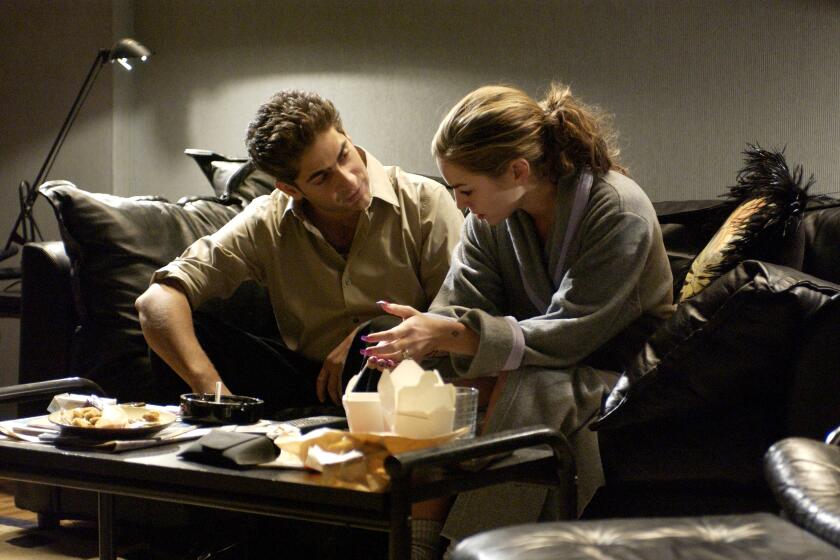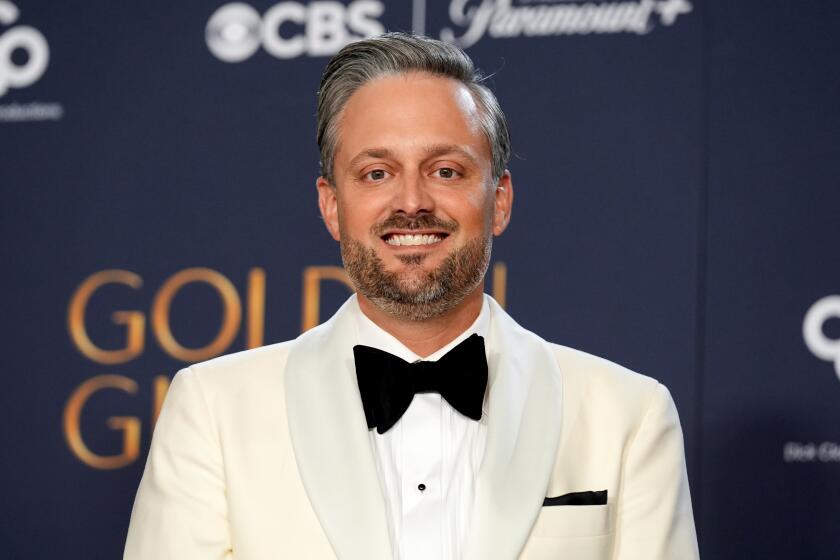A mutilated CPR dummy. A cat crashing through the ceiling. Inside one of ‘The Office’s’ best episodes

- Share via
In “Inside the Episode,” writers and directors reflect on the making of their Emmy-winning episodes.
A CPR dummy is turned into one of Buffalo Bill’s victims from “The Silence of the Lambs.” A cat falls through the ceiling. The world’s best boss (in his own mind), Michael Scott, gets roasted. These are just some of the antics that make up “Stress Relief,” a two-part episode that aired in 2009 during the fifth season of NBC’s mockumentary “The Office.”
Jeffrey Blitz would win a comedy directing Emmy that year for overseeing all of this chaos. Blitz, who broke into the business with his Oscar-nominated 2002 documentary “Spellbound,” talks to The Times about the rules for directing a scripted comedy to look like a serious documentary, the art of cat stunts and comedian Cloris Leachman’s commitment to her craft.
Terence Winter reflects on writing his Emmy-winning “Sopranos” episode in which Adriana is killed.
I’m not sure if there’s an easy way to answer this, but what are some of the major differences between directing an actual documentary and directing a comedy meant to look like a documentary?
The look is really the only similarity, and that’s a ruse, of course. Actual life doesn’t stick to a script, doesn’t have more than one take, can have pretty iffy craft service. “The Office” as a mockumentary borrows the style of a doc, but otherwise it’s as scripted as any scripted show — with one exception: the amount of improv. Even there, it’s less like real life and more like playing games.
What are some things to remember about making a mockumentary look like a documentary? How do you keep the setups original? Were there rules on “The Office” about how much originality could be used for the interview segments where the characters would explain things directly to the camera?
There were rules to our shooting. Or, maybe better to say, there were standard procedures that usually originated with showrunner Greg Daniels. As directors would drop in for episodes, they would learn these basic ideas. We were always free to challenge those standing rules, but it was never done just to be “fresh” — it always had to be a choice rooted in character and story. In a bigger sense, though, a camera would almost never go where a camera operator on a documentary, or a camera mount, couldn’t exist. We tried to be faithful to that, not out of duty-bound sense but because it helped to create the feeling of actual humans watching/recording/present at all times.
Were there rules in place as to how often the camera people ”filming the documentary” could or would get involved? This episode starts with Dwight (Rainn Wilson) starting a fire to test his co-workers’ emergency preparedness training. The supposed camera operators making this documentary don’t stop him from doing so. But they do alert Pam (Jenna Fischer) that there is a fire.
The basic approach was the camera team should never get involved, like in a traditional kind of documentary. But, like in the real world, when the human stakes rise to a level where movie ethics are a smaller concern because actual life is on the line, things get hairier. I can imagine that, were I part of the doc crew and a Dwight-like goon started a fire, I would feel the scene is worth getting without intrusion and there’s plenty of ways it gets handled before it’s out of hand. On the other hand, if I felt the staff — and the doc crew — were genuinely at risk, I would feel comfortable taking off my documentarian hat and putting on a more human one.
‘The Office’ stays true to its heart, even after 9 seasons
Dwight soon learns that his co-workers don’t stay calm under pressure. Ailurophile Angela (Angela Kinsey) rescues a cat she’s been hiding in the office and tosses it up to Oscar (Oscar Nuñez), who is trying to escape through the ceiling. It fails and the cat comes crashing through another part of that ceiling. What was the cat casting process like? How did you decide on that cat? How many takes did you have to nail the cat gag and the Oscar gag?
In the original script, Angela threw the cat into the ceiling and Oscar simply kicked it back down. I thought it was way too mean-spirited for Oscar. Walking the set, looking for a funny alternative, I pitched to have it sail through Oscar’s hands, vanish into the open part of the drop ceiling and drop unexpectedly through another ceiling tile.
We very quickly ruled out a stuffed toy cat — even realistic ones seemed phony — and concocted instead a highly elaborate approach that involved using two cats that looked identical. One would be the one Angela’s cat-throwing stunt double would toss up into the arms of a cat wrangler hiding in the ceiling behind Oscar. That wrangler would safely catch the cat. About six feet behind them, another cat wrangler was hidden in the ceiling with a matching cat positioned above an already scored ceiling tile so that the matching cat could be more safely dropped.
But the best laid plans of cats and men. … On the day of shooting, Angela’s stunt double tossed Cat 1 into the ceiling, but the cat catcher missed — though it was unseen by the cat dropper behind her. Which meant two identical cats actually plunged through the ceiling, one as intended, the other pretty freaked out but OK after taking the ride of his life. We were filming with two cameras and luckily one of the cameras happened to miss the second cat drop, so we were able to use that angle to keep the gag. After that, there were no more takes with the cat. By the way, I thanked the cat when I won the Emmy for that episode.

Were there conversations about how elaborate you could go there without losing believability?
By Season 5, the tone of the show, the world it was living in, was pretty clear to everyone working on it. I will say I think everyone knew we were going big for that cold open and some of the more normal episode backstops were taken out. For example: When Kelly Cantley, one of “The Office” assistant directors, initially broke down the schedule, all the segments of that cold open were supposed to fit in half a day. I told Kelly I wanted to go big here and to devote a full day to just the cold-open pieces — a very rare allocation of time on “The Office” — but she got it and rearranged the schedule to give me the full day for those pieces.
Dwight’s fire-alertness test fails and Stanley (Leslie David Baker) has a heart attack, causing the staff to go to CPR training. Dwight mocks this and butchers the CPR dummy so he can wear its face as a mask as if he were the serial killer in “The Silence of the Lambs.” How many CPR dummies had to die for that face? What were the conversations like with the props department on how that would look? What was it actually made of? Because I always think it looks like Silly Putty.
The CPR dummies were the work of “The Office’s” prop master extraordinaire, the late Phil Shea, who experimented with the real material of a CPR dummy and found it could work well. Rainn nailed the action early on, so it wasn’t as many horrifically ruined dummies as it might have been. The actor who played the CPR instructor was a real CPR instructor who, as I recall, was completely agog at her luck to land the part. She just kept charmingly saying how special this all was, giving voice to what I, and a lot of us, felt about working on that show.
This episode is also unique because there’s a movie within the show. Pam, Jim (John Krasinski) and Andy (Ed Helms) illegally download and watch a fake indie where a character played by Jack Black breaks up with his girlfriend, played by Jessica Alba, to be with her grandmother, played by Cloris Leachman. How did that casting come about?
As I recall — and all this should be questioned by those who care because, you know, it was 2008 when we had all this fun — Jack had already signed on while the script was still being written. Initially the Cloris Leachman role was imagined for Angela Lansbury, who wasn’t available. And Jessica signed on after Jack and Cloris were doing it. There were several different versions of what the movie would be, what genre even, before this kind of “Graduate”-like indie film came into focus.
One story I love from filming this is the clip where Jack takes Cloris from the tub. Cloris — who was a committed actor through and through — wanted to play the scene nude, without the usual flesh-colored bathing suit, to really sell the passion. She had to be talked down, for the sake of keeping an orderly and swiftly moving set. But I will forever treasure the discussion between me, Cloris and Jack.
Is the anxiety-inducing “The Bear” really a comedy? And how do you classify “Shōgun,” a series that already fully adapted James Clavell’s novel?
At some point, Steve Carell’s Michael Scott, the boss of this operation, decides he needs to bring the team together for a Friars Club-style roast of him. This backfires and the jokes get pretty cruel. I don’t know if any of the roasts were improvised, but did Carell know what was going to be said ahead of time? How did you work to get reactions from not just him but everyone else in the room? Were there any jokes that got changed because they were just too mean?
The roasts were all scripted, at least in basic form. But look, it’s Steve Carell we’re talking about. The man’s talent for grounding himself, for making himself real and present and alive, in situations that might otherwise seem patently absurd, is unsurpassed. There were plenty of jokes that got cut, but it was more in the interests of time than because the tone was too far.
I’m sure we modulated on set and that editorial choices were made to shade it, but everyone knew the target. It was Steve’s idea to give himself a kind of Nixonian posture as he realizes he’s a target of ill will. I always loved that choice — even then, even childlike and hurt, Michael Scott is grandiose in effect.
The episode’s catalyst is Stanley’s heart attack and it ends with him giving a huge, throaty laugh when Michael roasts him. This makes it feel like everything is forgiven. How important was it to end the episode on Stanley’s laugh? How did you work with Baker to get such a guttural response?
Leslie’s laugh is genuinely Leslie through and through. There was no keen director’s work on my part except that I knew to stand back and let him be him.
More to Read
From the Oscars to the Emmys.
Get the Envelope newsletter for exclusive awards season coverage, behind-the-scenes stories from the Envelope podcast and columnist Glenn Whipp’s must-read analysis.
You may occasionally receive promotional content from the Los Angeles Times.










